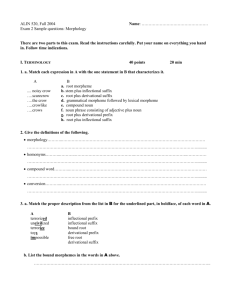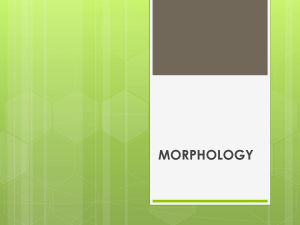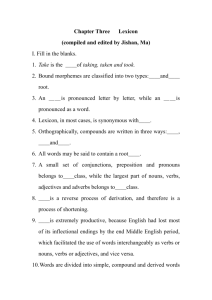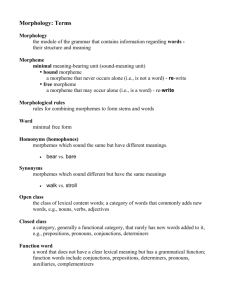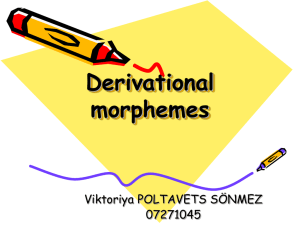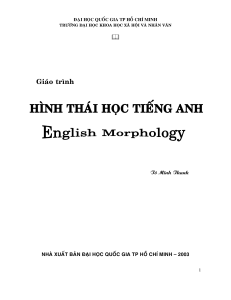Morphology March 8th updated
advertisement
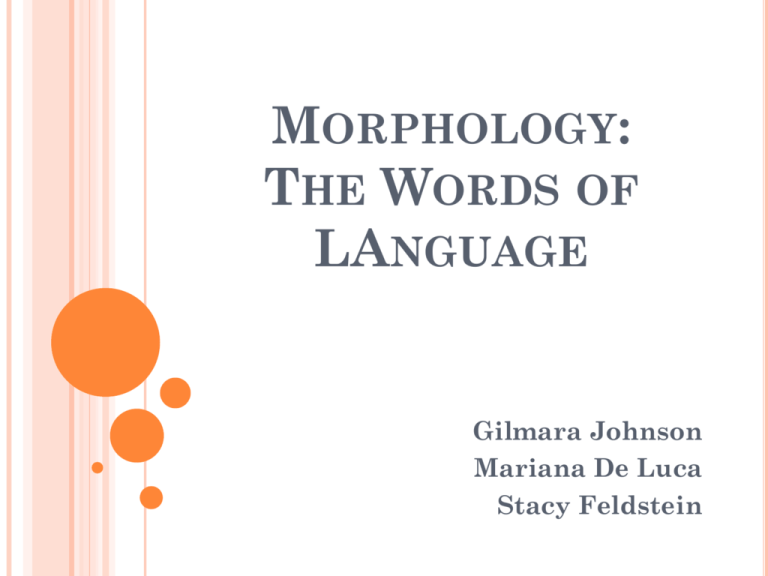
MORPHOLOGY: THE WORDS OF LANGUAGE Gilmara Johnson Mariana De Luca Stacy Feldstein HOMEWORK At your table, discuss your responses for the questions and answers you chose from the homework. 7 minutes MORPHOLOGY: THE STUDY OF THE STRUCTURE OF WORDS PAGE 34 1. 2. 3. 4. 5. 6. 7. Copyeditor: Adeline Moore Accounts payable: Ineeda Czech Pollution control: Maury Missions Purchasing: Lois Bidder Statistician: Marge Innovera Russian chauffeur: Picov Andropov Legal firm: Dewey, Cheetham, and Howe 1. (add a line more) 2. (I need a check) 3. (more emissions) 4. (lowest bidder) 5. (margin of error) 6. (pick up and drop off) 7. (Do we cheat 'em? And how!) CONTENT WORDS AND FUNCTION WORDS Content Words Function Words Open class Closed class Denote concepts such as objects, actions, attributes and ideas Have no clear lexical meaning or concept attached to it Specify grammatical relations Nouns, Verbs, Adjectives and Adverbs articles, conjunctions, prepositions, pronouns WHAT KINDS OF WORDS IS HE TALKING ABOUT, “CONTENT” OR “FUNCTION”? SEGMENTING SOUNDS THECATSONTHEMAT VS. UNCHARACTERISTICALLY JIGSAW READING Read your section and prepare to present a poster with the main ideas to the class. Group 1: Morphemes: The Minimal Units of Meaning (pp.36-38) Group 2: Bounds and Free morphemes (pp. 3942) Group 3: Roots and Stems, Bound Roots (pp.4244) Group 4: Rules of word formation, Derivational Morphology (pp. 44-46) Group 5: Inflectional Morphology (pp. 46-49) Group 6: Compounds (pp.57) GRAPHIC ORGANIZER As groups present, use you graphic organizer to take notes on the “Description” section. At your tables, use you notes to discuss and complete the “classroom applications” section. You can explain how morphological knowledge affects language teaching or you can design a teaching activity that would help students learn that morphological aspect of language. Share with the class: Pick one concept (different from the one you presented) to show how it applies to teaching ELLs. MAIN DIVISIONS OF WORD CLASSES (PARTS OF SPEECH): Content Words Function Words • • • • Nouns Verbs Adjectives Adverbs • • • • Conjunctions Prepositions Articles Pronouns EXERCISE: DETERMINE THE WORD CLASS OF EACH OF THE FOLLOWING WORDS a. b. c. d. e. f. g. h. i. canine the him elegant inconvenience eloquently comply inasmuch as over a. b. c. d. e. f. g. h. i. Noun Article Pronoun Adjective Noun Adverb Verb Conjunction Preposition MORPHEME: THE MINIMAL UNIT OF MEANING Free morpheme: a single morpheme that constitutes a word and can stand alone. Bound morpheme: a morpheme that must be attached to another morpheme. QUESTION #2 A, B, I, J, K, L, M Example: Retroactive = retro + act + ive Free morpheme = act Bound morphemes = retro-, -ive ENGLISH AFFIXES (BASED ON THE POSITION) Prefix: An affix that occurs before a morpheme Suffix: An affix that occurs after a morpheme ENGLISH PREFIXES Examples of Negative Prefixes: un- nondisaExamples of size and degree prefixes: minisubover- super- ENGLISH SUFFIXES Class preserving suffixation: -er lecturer -ian librarian -ist scientist -let piglet Class changing suffixation: Verb Noun perform performance Adjective Adverb nice nicely Adjective Noun active activity AFFIXES (BASED ON THE FUNCTION) Inflections vs. Derivations DEFINITION Derivational morpheme: deriving (creating) a new word with a new meaning. Inflectional morpheme: changing the form of a word because of the rules of syntax. ENGLISH INFLECTIONAL MORPHEMES Nouns –s plural –’s possessive Verbs –s third person singular present –edpast tense –en past participle –ing progressive Adjectives –er comparative –est superlative SOME EXAMPLES OF ENGLISH DERIVATIONAL MORPHEME -ic -ance -ly -ity -able : Noun Adj : Verb Noun : Adj Adv : Adj Noun : Verb Adj ; alcohol alcoholic ; clear clearance ; exact exactly ; active activity ; read readable -ship : Noun Noun ; friend friendship re- : Verb Verb ; cover recover in- : Adj Adj ; definite indefinite DESCRIBE THE ITALIC AFFIXES: 1) 2) 3) 4) 5) 6) 7) impossible terrorized terrorize desks dislike humanity fastest 1) Derivational prefix 2) Inflectional suffix 3) Derivational suffix 4) Inflectional suffix 5) Derivational prefix 6) Derivational suffix 7) Inflectional suffix Describe the italic affixes: 8) 9) 10) 11) 12) 13) 14) premature untie darken fallen oxen faster lecturer 8) Derivational prefix 9) Derivational prefix 10) Derivational suffix 11) Inflectional suffix 12) Inflectional suffix 13) Inflectional suffix 14) Derivational suffix PHONOLOGY/MORPHOLOGY REVIEW Test Question: PHONOLOGY/MORPHOLOGY REVIEW Test Question: PHONOLOGY/MORPHOLOGY REVIEW Test Question: PHONOLOGY/MORPHOLOGY REVIEW Test Question: PHONOLOGY/MORPHOLOGY REVIEW Test Question:
